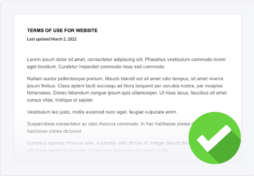If you run an ecommerce business, a terms and conditions agreement is a valuable asset to have posted on your website or app.
The terms and conditions for your online store sets the rules your customers must follow while using your services, limits the liabilities that fall on your business, and establishes your property rights, which may help you avoid — or resolve — potential legal disputes.
In this article, we’ll explain what a terms and conditions agreement includes and why it’s important, then look at example terms and conditions for online stores, and provide you with our free ecommerce terms and conditions template.
- What Are Terms and Conditions?
- Does My Online Store Need Terms and Conditions?
- What to Include in Terms and Conditions for Online Stores
- Where To Display Your Online Store’s Terms and Conditions
- Ecommerce Terms and Conditions Examples
- Tips for Having a Good Ecommerce Terms and Conditions
- How to Make Your Ecommerce Terms and Conditions Enforceable
- Ecommerce Terms and Conditions FAQ
- Why Use an Ecommerce Terms and Conditions Template?
- Ecommerce Terms and Conditions Template [Free Download]
- Summary
What Are Terms and Conditions?
Your ecommerce website’s terms and conditions are a legal agreement between you and your customers outlining all rules, restrictions, and disclaimers they must follow when using your services.
Standard terms and conditions for online stores usually include details about payment terms, acceptable website or app usage, dispute resolutions, and more.
There are many alternative names for terms and conditions that you might see on websites or apps, like:
- Terms of Use
- Terms of Service
- General Conditions
Our free, downloadable ecommerce terms and conditions template is fully customizable, including the title, and applies to all of the following online stores:
- Ecommerce websites and apps
- Marketplace shops
- Retail or clothing stores
- Dropshipping businesses
Does My Online Store Need Terms and Conditions?
While you’re not legally required to have a terms and conditions agreement, you need one for your online store, so you have a set of enforceable rules should any dispute with a customer arise.
No matter what type of ecommerce business you own, making a terms and conditions agreement is in your best interest, as this policy helps
- Protect your online store from website abuse
- Limit what your store can be held liable for
- Protect your intellectual property
- Minimize disputes
- Establish trust and transparency between you and your consumers
Let’s go over the benefits of having an ecommerce terms and conditions agreement in more detail.
Terms and Conditions Help Prevent Website Abuse
One of the primary purposes of terms and conditions for ecommerce websites is to outline the rules and restrictions you expect your users to follow when accessing your services, which helps minimize website abuse.
Within this policy, you can list all unacceptable behaviors and any disciplinary actions you’ll take if someone breaks those rules.
You might ban things like:
- Excessive spamming in your comment sections
- Using bots or malware to infect your website
- Posting defamatory content
- Aggressive behavior or language
- Illegal activities
Having terms and conditions in place allows you to take action against site abusers who break the guidelines you set in your policy.
For example, you might ban the user or terminate their account.
By making this agreement easy for your users to find, you’re setting the expectations and guidelines on proper website usage, acceptable actions, and the consequences of breaking those rules.
Terms and Conditions Help Limit Your Ecommerce Store’s Liabilities
Within your terms and conditions, you can include disclaimers that help protect your ecommerce business from being held accountable for liability issues, such as:
- Personal injury
- Loss of profits
- Computer malfunction
- Product misrepresentations
- Warranty issues
It also helps protect you from being held responsible for minor oversights if the content on your website or app is outdated, incomplete, or inaccurate.
Limiting your business’s liabilities within your terms and conditions could help save you thousands of dollars in legal fees down the road.
Terms and Conditions Help Protect Your Intellectual Property
As the owner of your online store or shop, you also own your website’s content, logo, page designs, and any other brand-related materials you produce.
You can use your terms and conditions to inform users that these properties are protected by copyright and trademark laws and explain if and how others can lawfully use your materials.
Suppose someone does try to steal or reproduce your intellectual property, including photos, design elements, and other content outlined within your terms and conditions. In that case, you’ll have the proper grounds to possibly pursue legal action.
Terms and Conditions Help Minimize Disputes
A well-drafted terms and conditions agreement clearly lays out the rules your users are expected to follow, which can help address unhappy, confrontational customers and minimize your chances of legal disputes.
If any friction does occur, you can look to the dispute resolution clause within your terms and conditions for a clear plan of action, leading to easier conflict resolution for you and your team.
Terms and Conditions Help Establish Trust and Transparency
Terms and conditions help your ecommerce business establish trust and transparency with your customers because this agreement properly sets users’ expectations.
By clearly outlining the rules of your website or app and explaining the legal basis on which your business runs, your customers will likely have more clarity about your online store.
What to Include in Terms and Conditions for Online Stores
The specifics within your online store’s terms and conditions vary depending on what type of business you conduct.
That being said, in the next section, we cover the clauses typically included in standard ecommerce terms and conditions agreements.
Introduction Clause
The introductory clause of your ecommerce terms and conditions agreement can help establish your customer’s expectations.
Here is where you introduce your company and outline who and what the agreement covers. You should also state within this first clause that anyone using your services agrees to the terms and conditions outlined in your policy and provide stipulations for people who may disagree.
The ecommerce terms and conditions sample below comes from T-Mobile. Their intro clause clearly states who their agreement is between and how users can accept the guidelines.
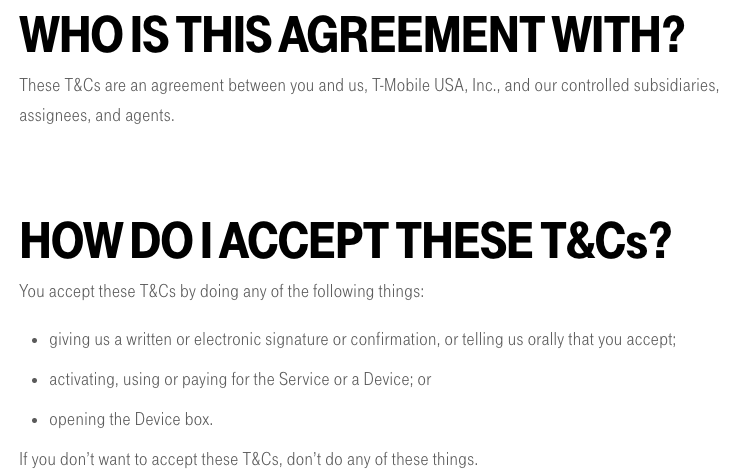
Prohibited Use and Activities
Your online store’s terms and conditions act as the literal rules your users are expected to follow when accessing your services, so you should include a clause clearly communicating all of those guidelines.
For an ecommerce business, it’s best to come up with relevant rules based on the ways you allow your users to interact with your online store and with each other.
Then you can list all prohibited and restricted activities that you won’t allow on your website or app within this clause, which may include things like:
- Posting obscene, violent, or crude content
- Breaking the law
- Harassing or stalking other users
- Violating copyright laws
- Hacking, introducing viruses, or tampering with your website or app
- Conducting scams
- Spamming the service or other users
In the example below, you can see the prohibited uses Apple includes in their iTunes terms and conditions agreement.

You might want to separate this clause into an acceptable use policy (AUP) document, depending on the type of website or app you own.
Your AUP will still be part of your terms and conditions but can be shared independently from the rest of your terms in relevant places where you want your users to know exactly what rules they’re expected to follow.
If you want to make a free AUP in minutes, check out our Acceptable Use Policy Generator.
Account Termination and Suspension
If your online store allows your users to interact with one another through their accounts or profile pages, you should have a termination clause for responding to users who violate the guidelines outlined in your ecommerce terms and conditions agreement.
By clearly communicating this information in your policy, you can streamline the disciplinary process in case anyone breaks your rules. Let your users know if their accounts will be suspended or terminated due to breaking the agreement.
It’s a good idea to leave this clause as broad as possible, giving you more wiggle room to manage unnecessary or agreement-breaking accounts.
Read the highlighted text below, again from Apple’s iTunes terms and conditions agreement, for an example of how you might phrase this clause in your own policy.

But if your online store does not allow users to create accounts, or if their accounts only get used for purchasing goods from your website, then this clause may not be necessary for your ecommerce terms and conditions.
Intellectual Property Rights
Your ecommerce business probably has intellectual property that you want to protect, which you can outline in a clause in your terms and conditions agreement.
Intellectual property refers to your business’ trademark and copyrighted content, including:
- Images
- Names
- Logos
- Patents
- Videos
- Designs
Because you run an ecommerce business, you should also outline your ownership over any unique software, screen displays, web page designs, or HTML coding used on your website or app.
Within this clause, you should list the materials that belong to your business and outline rules and restrictions that apply to outside parties who might try to use your materials. You might also consider including a copyright disclaimer.
Once again, the iTunes terms and conditions, pictured below, does a good job listing out the different properties and materials that they maintain the rights over.
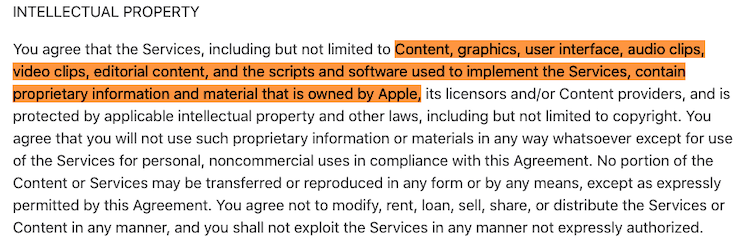
Privacy Agreements
If your ecommerce store falls under certain data privacy laws like the General Data Protection Regulation (GDPR) and the California Consumer Protection Act (CCPA), you may be required to have a privacy policy and cookie policy on your website or app.
It’s a good idea to link those policies directly in your terms and conditions agreement so it’s easy for your users to find them, like how T-Mobile does it in their agreement pictured below.
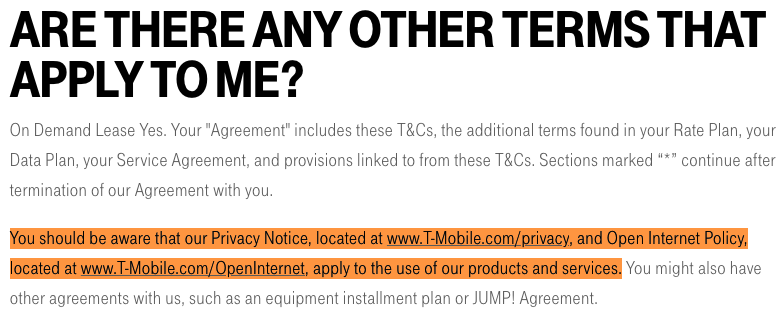
Product or Promotional Information
You can create a clause in your terms and conditions that protects your ecommerce store from any discrepancies or inaccuracies about the products posted on your website or app.
For example, you can use this clause to reserve the right to end promotions or sales early or to reject promotional codes after a certain period.
Read the highlighted text below from Best Buy’s sample terms and conditions to see how they use proper phrasing to help prevent website inaccuracies from causing them harm.

Pricing and Payments
Your pricing and payments clause in your ecommerce terms and conditions should address all online purchase questions and pricing-related topics.
Here you can tell your customers about
- The methods of payment you accept
- What happens if they miss or do not make a payment
- What type of currency you take
You can read through our guide on how to write payment terms for tips on making the most out of this clause.
Our example terms and conditions below is from Best Buy again, because their payments clause is very easy to read and understand.

Return and Refund Information
Your online store should include a clause in your terms and conditions covering how you handle returns and refunds, because chances are high that your customers will have questions about these procedures.
If you use any of the following policies, link them directly in your return and refund clause:
Below, you can see the short and sweet returns clause from Michaels online terms and conditions, which provides two links directly to the relevant policy and explains that it’s incorporated into their terms and conditions.

Shipping and Delivery Information
Your ecommerce store probably answers a ton of customer questions about your shipping and handling processes, so be sure to include a clause covering those details in your terms and conditions.
You should also include a link directly to your shipping policy within this clause, that way, your users can easily access it if they have further questions.
In the example below, see how Adidas mentions their shipping policy within their terms and conditions.

They also link to their terms and conditions directly in their shipping policy, as shown in the yellow highlighted text below, which you should also consider doing.
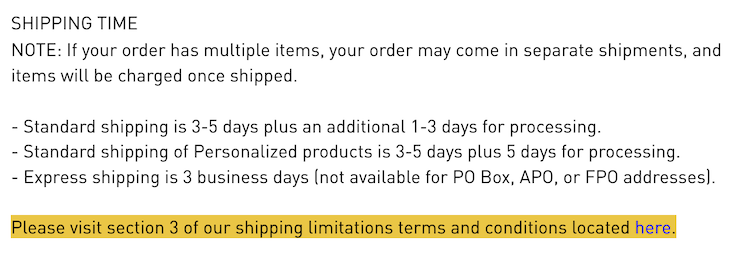
User-Generated Contributions
If your ecommerce store allows your users to generate content or contribute to your site in some way, outline all relevant rules, guidelines, and stipulations in a clause within your terms and conditions agreement.
See how Best Buy phrases this clause in their terms and conditions in the highlighted text below.

Of course, if your online store doesn’t provide your users with a public forum or a place to post content, then this clause may be unnecessary in your ecommerce terms and conditions.
Limitation of Liability
Your ecommerce terms and conditions agreement is one of the best places to include a liability disclaimer to help remove certain responsibilities from falling onto your business, should something ever occur on your website or app.
A liability disclaimer is a statement from your online store that denies responsibility for damages your visitors may suffer as a result of using your service. It also informs users about what they cannot sue you over.
Take a look at an example of a liability limitation clause from Target’s terms and conditions below.
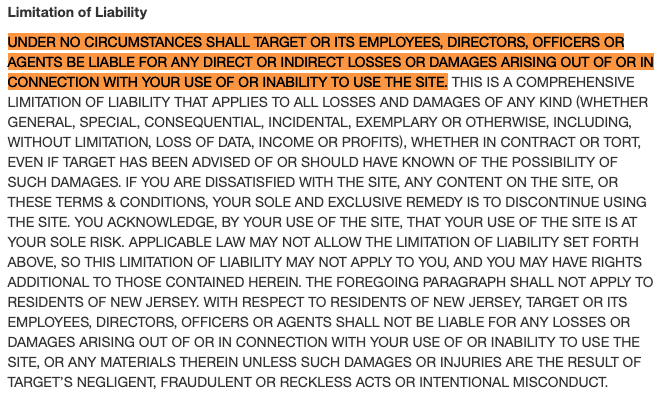
Third-Party Links
A third-party links clause in your ecommerce terms and conditions explains the purpose of any external links on your website and clarifies that you do not have control over the content on those pages.
The highlighted text below from Best Buy’s terms and conditions is a great example of how to phrase your third-party links clause.

Amendments or Changes to the Agreement
Your online store’s terms and conditions are a living document that you can update as much as you need to, so have a protocol in place for updating your users about any changes you make to the policy.
A common way to do this is by marking the last revised date somewhere on your policy, usually in the header. But you can also include a short clause setting your users’ expectations, like how T-Mobile does it in the screenshot below.
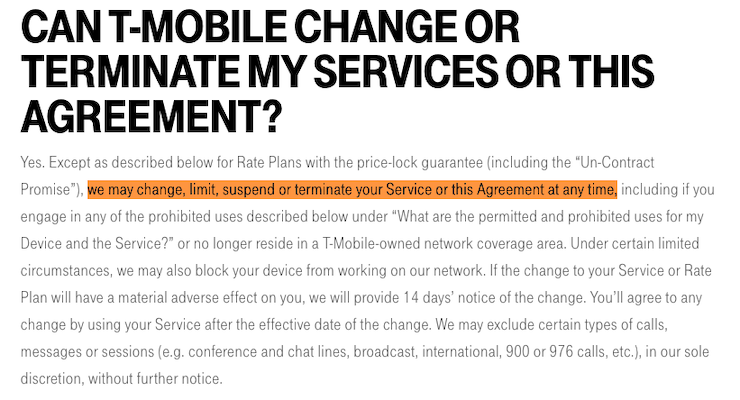
Dispute Resolution
Your dispute resolution clause, sometimes called a Governing Law clause, should describe how conflicts and controversies related to your ecommerce terms and conditions agreement are handled.
There are three ways your ecommerce website might handle a dispute:
- In court: If you want to settle customer disputes in court, explain which courts will handle the cases, the location of the court, and the governing laws that apply.
- Binding arbitration: If a mediator or arbitrator will settle your disputes, describe where the arbitration will take place, the legal regulations that apply, how fees are handled, and what the general process looks like.
- Informal negotiations: If you want to resolve disputes through direct negotiations with customers, include detailed information about the timeline for negotiations and how the process will work.
You should clearly outline all guidelines for whatever dispute method your ecommerce business chooses to use.
Below, see how T-Mobile clearly explains their dispute resolution processes within their terms and conditions.
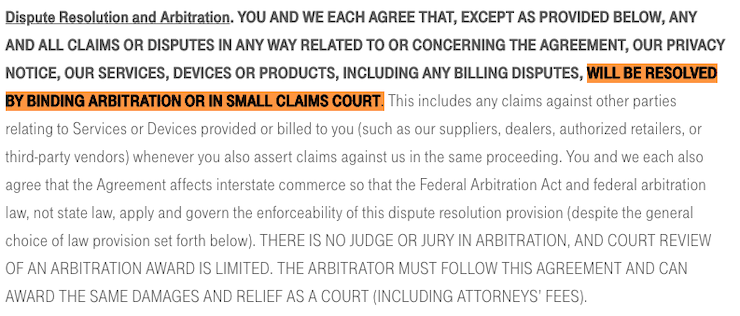
Company Contact Information
At the end of your online store’s terms and conditions, you should include your contact information so your users can reach you or the right team if they have questions, comments, or concerns.
The sample ecommerce terms and conditions pictured below from T-Mobile provides several contact options for their customers.
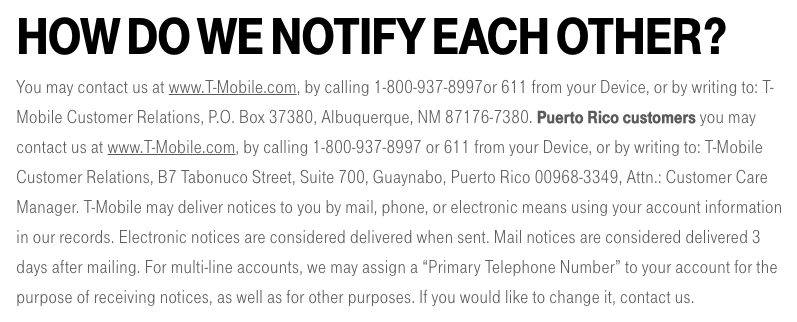
Since your ecommerce business operates online, it’s okay if you don’t list a physical address as long as the email address or phone number you include within this clause are accurate.
Where To Display Your Online Store’s Terms and Conditions
You should display your terms and conditions in multiple spots throughout your online store so your users can always find it.
Below, we go over the most common places to post links to your terms and conditions for your ecommerce business.
Website Footer
You should link your online store’s terms and conditions in the footer of your website.
Not only is this the most common place for terms and conditions to appear, but it also ensures your users can access the document no matter what part of your website they end up on.
Below is a screenshot of the footer from Best Buy’s website, where they link to their terms and conditions.
![]()
Payment Screens
Another place you might consider posting a link to your online store’s terms and conditions is on your payment screens.
We’re using Best Buy as our example again, because they also provide a link to their terms and conditions at the bottom of their payment screen, as highlighted below.
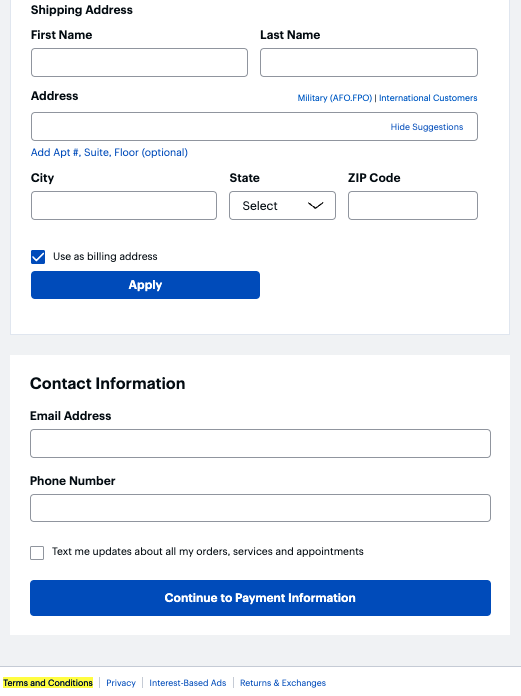
Account Creation Page
If your online store allows users to create logins, the new user account creation page is a great spot to include a link to your ecommerce terms and conditions.
You want customers using your services to know the rules they’re expected to follow on your website or app, so it makes sense to provide them with a link before officially creating a profile.
Below, we’re using Best Buy as our example for the third time, because they also link to their terms and conditions on their new account creation page.

All that being said, if your ecommerce store doesn’t provide your customers with profile pages or user accounts, then you can skip this one.
Privacy Center
A privacy center is a central hub where you can post all legal policies, privacy information, and agreements that you want your users to always have access to.
For tips on how to set one up on your website, read through our article covering all you need to know about privacy centers.
Once you make one, you can link to it in the footer of your website, as shown in the example below from T-Mobile.
![]()
Ecommerce Terms and Conditions Examples
Let’s look through some examples of ecommerce terms and conditions from popular online stores to see how you can apply these clauses to your own website.
American Eagle’s Terms and Conditions
It’s common for ecommerce stores to include a section on products and purchases in their terms and conditions.
Below, we use an example from American Eagle’s terms and conditions, because they have a great clause that clearly explains their purchasing process, potential pricing and availability errors, and online payment methods.
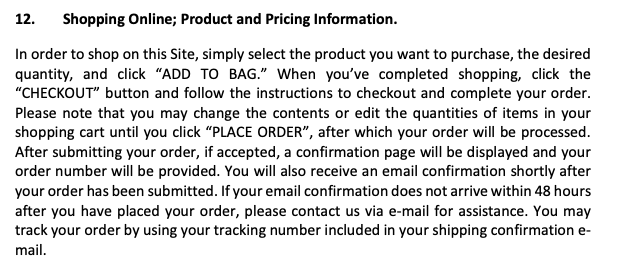
Like the example terms and conditions above, it’s a good idea to lay out your online store’s rights when it comes to:
- Changing prices
- Updating product information
- Suspending promotions
- Canceling orders
American Eagle also offers a good example of an intellectual property clause specific to ecommerce stores, pictured below.
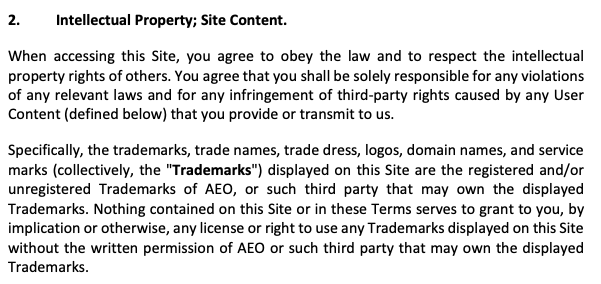
Because they produce their own brand-related designs and content, American Eagle includes an intellectual property clause to prevent others from improperly using their original materials.
If your online business produces original materials that you want to protect, you can follow American Eagle’s example by listing the items that you own and describing the circumstances under which other parties are and aren’t allowed to use them.
Target’s Terms and Conditions
Another good example of standard terms for online stores comes from Target. They cover various topics, including user accounts and transactions, terms for Target’s services, and other legal policies Target offers.
As with most standard ecommerce terms and conditions, they include a limitation of liability clause, pictured below.
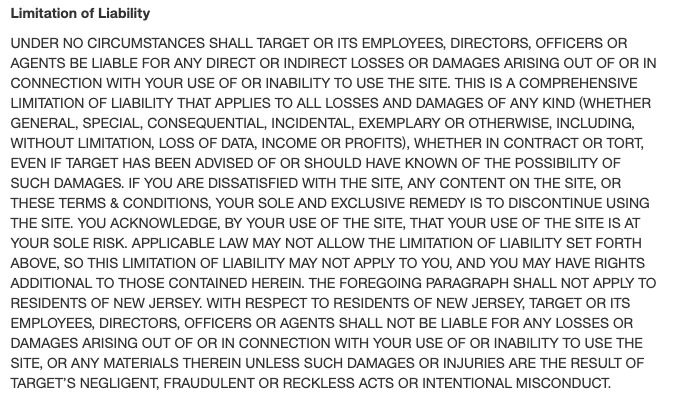
Target also provides users with a separate warranty disclaimer, as shown below.

Target’s limitations of liability clause and warranty disclaimers are important in preventing them from being held accountable for damages, injuries, or losses users might experience while using their website.
Your online store should include both a liability disclaimer and a warranty disclaimer to maximize legal protection, whether presented as separate clauses like in the above example from Target or combined under one clause.
Walmart’s Terms and Conditions
If your online store allows user feedback, you need to include a user submission clause to outline the rules and consequences around submitting content.
In the screenshot below, see how Walmart’s terms and conditions explain that users who submit content on their site grant Walmart permission to edit, display, and distribute the content.
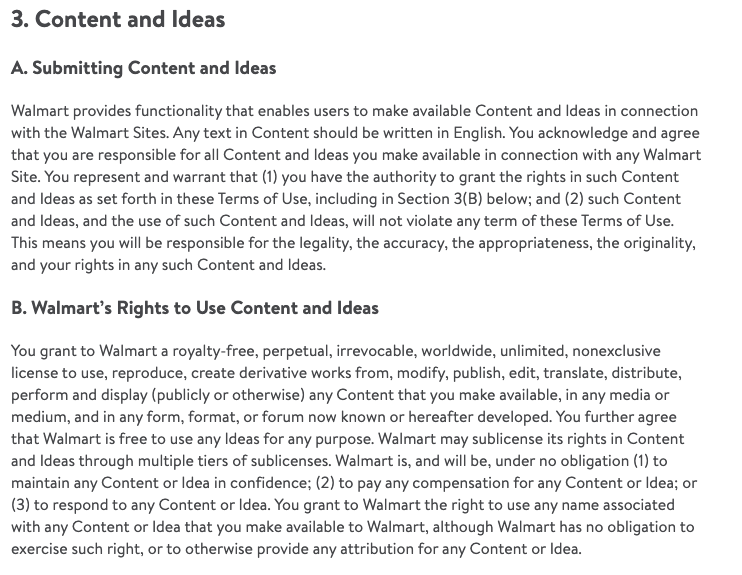
User feedback can be valuable for your online business, so consider including a clause to ensure contributors are aware of the rules for posting and know who has the right to their content.
Best Buy’s Terms and Conditions
As we mentioned previously, terms and conditions are a proactive measure to help your ecommerce business avoid legal disputes. However, if one does occur, it’s important you have a clear dispute resolution clause in place to resolve conflicts quickly.
Take, for example, Best Buy’s terms and conditions, pictured below. They clearly explain that disputes will be resolved through arbitration by default.

Further in this clause, Best Buy defines the terms of the arbitration, applicable laws, and all related fees.
To ensure your online store is prepared to handle potential conflicts quickly and inexpensively, include a dispute resolution clause within your ecommerce terms and conditions.
Tips for Having a Good Ecommerce Terms and Conditions
Here are a few of our tips for writing a good ecommerce terms and conditions agreement.
Make your Ecommerce Terms and Conditions Easy to Read
If you decide to write the terms and conditions for your online store yourself, make sure it’s easy to read.
You want all of your customers to understand what they’re agreeing to when they access your services or select a checkbox to agree to the terms and conditions.
Include Relevant Clauses in your Ecommerce Terms and Conditions
The clauses within your terms and conditions agreement will vary depending on what type of business you conduct, so pick and choose the ones that are most relevant to your online store.
For example, if you sell perishable goods, you might need different clauses in your terms and conditions than a business that only sells clothing.
It’s also usually more important for ecommerce businesses to include return clauses and shipping clauses in their terms and conditions, as these are some of the primary ways you interact with your customers.
As you make your own terms and conditions for your online store, choose the clauses that fit the needs of your business best, just be mindful to not leave out anything important.
Don’t Plagiarize Another Online Store’s Terms and Conditions
No matter what you do, don’t copy another online store’s terms and conditions. Copying someone else’s agreement is considered plagiarism, and legal documents are copyrighted.
Terms and conditions vary drastically from one business to the next, and someone else’s policy will not cover all of the details, stipulations, and specifics that your online store requires.
How to Make Your Ecommerce Terms and Conditions Enforceable
Your ecommerce terms and conditions are enforceable as long as you post them on your website or app and get user agreement to the policy, which can be done in the two ways we cover below.
Clickwrap Method for Consent
To get your users to consent to your online store’s terms and conditions actively, consider using what is known as the clickwrap method, which essentially means you have your users select a checkbox to express they’ve read and agree to your terms.
If you get active consent from your users for your terms and conditions, it’s easier to prove in court that they read and understood the agreement.
In the screenshot below, see how American Eagle uses clickwrap consent for their terms and conditions and privacy policy when someone signs up for a new user profile.

Implied Consent
Another way to get your users to agree to your online store’s terms and conditions is through implied consent or browsewrap.
Implied consent means users agree to your terms and conditions through an action.
Most online stores that use browsewrap consent methods include a sentence at the beginning of their terms and conditions stating that the user agrees to the policy by using any of their services.
In the example below, the highlighted text from Walmart’s terms and conditions implies user consent because it clearly states that anyone who disagrees with any of the terms is unauthorized to use all Walmart Sites.
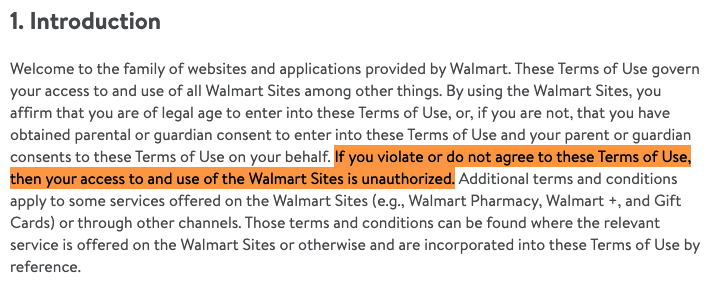
Implied consent for your terms and conditions may be enough for most of the users on your website, but you should understand that this method only sometimes holds up in court.
If someone decides to pursue legal action against you, they could argue that they didn’t actually agree to your policy because they didn’t know that using your service also constituted consenting to the agreement.
We recommend using both clickwrap and implied consent methods for your terms and conditions agreement to best protect your online store.
Ecommerce Terms and Conditions FAQ
Below you can check out some of the most frequently asked questions we get about ecommerce terms and conditions.
What is a terms and conditions policy for an online store?
A terms and conditions policy for online stores outlines all rules, guidelines, property rights, and stipulations that you expect your users to agree to when using your services.
Why do online stores need terms and conditions?
Online stores need terms and conditions because they can help resolve potential conflicts with customers and may take some legal liabilities off of your business if one of your users ever breaks the law or misbehaves.
Where should you display your terms and conditions policy on your online store?
You should display your online store’s terms and conditions policy in the following places:
- The footer of your website
- On new user profile pages
- On checkout pages
- In your data privacy center or help center
How do I enforce my online store’s terms and conditions?
You can enforce your online store’s terms and conditions by using clickwrap consent methods, which refers to a user selecting a checkbox to mark that they’ve read and agree to your policy.
You can also use implied consent methods to enforce your ecommerce terms and conditions, like stating at the beginning of the policy that anyone using your services automatically agrees to it.
Why Use an Ecommerce Terms and Conditions Template?
If you want to make a thorough, easy-to-read terms and conditions agreement for your ecommerce business, we recommend using a template.
The best thing about using a template is that you don’t have to start the entire document from scratch, some of the initial writing is already done for you.
Our free ecommerce terms and conditions template also provides you with the most common clauses found in terms and conditions, allowing you to fully customize the document to fit any of your ecommerce needs.
There are plenty of free terms and conditions templates for online stores that you can choose from, but ours was designed to be simple to read and applies to most websites and apps.
Ecommerce Terms and Conditions Template [Free Download]
You can download our free ecommerce terms & conditions template below in Word Doc, PDF, or Google Doc format.
Before using it, read through the entire ecommerce terms & conditions template – fill in all of the [brackets], remove any sections that do not apply to your app, and tweak any language as needed.
Additional Template Download Options
Use this template to create terms and conditions for your:
- Online store
- Ecommerce website
- Marketplace shop
- Online clothing store
- Dropshipping business
Summary
Terms and conditions are important for your online store to minimize liabilities, protect intellectual properties, and possibly shield your business against legal disputes.
A comprehensive terms and conditions agreement ensures your users know what they can and cannot do on your ecommerce website or app, and gives you something to point to if anyone tries to break your rules or causes harm to your business.
Now that you’re ready to make your ecommerce terms and conditions, download our free template and customize the clauses according to your business needs.
If you’re looking for a different type of terms and conditions, check out the other templates that we offer:
| Terms and Conditions | Description |
| Mobile App Terms and Conditions Template | Terms and conditions for apps in various app stores |
| Website Terms and Conditions Template | Terms and conditions for websites and blogs |
| Terms of Service Template | For those who prefer terms of service |
| Terms of Use Template | For those who prefer terms of use |


